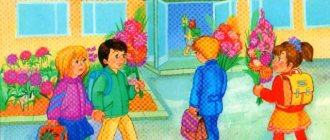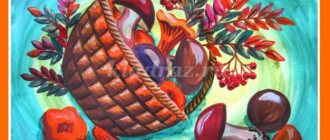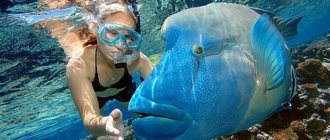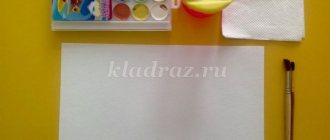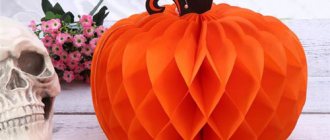Preparatory group. “Autumn”: what else can be done on this topic?
Of course, this time of year is famous for mushrooms. Children will also make them with pleasure. It’s better if they recreate a whole picture on canvas, where they capture a clearing, a corner of the forest. The mushroom is very easy to make. Its white leg is an oval, and its cap looks like an umbrella or semicircle. It can be yellow, red, brown. At this age, children can learn the names of edible mushrooms; the application will help them.
If the mushroom stems are white, then you can use a blue or light blue canvas for the painting. White wavy clouds will float above it and the yellow sun will shine.
You can add a touch of originality to the picture. Cut and glue the base for the tree - the trunk and knots. On a walk, collect small leaves, dry them or iron them, and let your child stick them on the tree. You can make a bird in a nest by gluing a real feather. If a preschooler outlines his palm, he will turn it into a bird. The thumb will become the head and beak, and the rest will become feathers. All that remains is to cut and glue the long thin legs and place the bird on or near a tree.
Methodology for preparing an open lesson
The process of preparing a demonstration lesson on application is no different from writing a script for a regular lesson. However, a number of nuances still need to be taken into account:
- an open lesson should have a plot (children help a fairy-tale character by going to visit a doll, giving her a gift, etc.);
- Children are expected to be more independent, so during demonstration lessons you should not involve types of appliqué that children have not mastered very well, for example, cereal or silhouette applique, despite the fact that most often the children dealt with tape and cotton pads;
- At the end of the lesson, mandatory reflection is carried out (the ability to evaluate one’s work is an important indicator of a child’s readiness for school).
An example of a demonstration lesson on applique involving drawing can be found in the publication of R.F. Bagieva “We are building a multi-storey house.”
How an open application lesson is analyzed
When considering a demonstration lesson in the artistic and creative direction in the preparatory group, inspectors pay attention to:
- compliance of the topic, goals and objectives of the lesson with those indicated in the course work program;
- the relevance of the methods and techniques used for children of this age and level of proficiency in the necessary skills and abilities;
- visual accompaniment of the lesson;
- availability of explanations;
- level of general training of children;
- timeliness of finger exercises and physical education;
- how the individual approach is implemented;
- emotional background of the lesson;
- How the teacher’s work was assessed and reflection was organized.
A spontaneous exhibition of children's works is a mandatory element of both open and regular classes.
A sample analysis of a lesson on applicative creativity can be found here.
Applications fruits and vegetables
Applications in the form of fruits and vegetables are quite popular; they are created by both younger and older children. Using them you can glue real compositions, and from different materials.
The depiction of fruits and vegetables using the appliqué technique facilitates their quick learning and memorization, which is very important for a small child.
Materials for their manufacture
To make applications depicting fruits and berries, you can use not only the usual material - colored paper, but also others:
- corrugated paper;
- felt;
- some types of fabrics;
- dried tree leaves and berries;
- seeds;
- cereals and pasta;
- beads;
- eggshells;
- threads
An application on this topic with several types of materials turns out to be quite interesting and original.
Technicians
As a rule, fruits and vegetables are depicted in the form of standard applications, but they also look very interesting in 3D volume. If desired, you can make the applique using the origami technique or by twisting narrow strips of paper.
They also often do work using the mosaic technique, that is, they tear paper or break eggshells into small pieces, and then fill them with the required image.
Caterpillar
Let's take a closer look at how to make a caterpillar from bottle caps.
You need: colored paper, colored cardboard, scissors, glue, markers, 5 bottle caps. The photo shows an option made from chestnuts, but the same thing can be made from bottle caps.
STEP 1. Using a template, cut out a large sheet from a sheet of green cardboard.
STEP 2. Draw the leaf veins.
STEP 3. Glue the lids to the sheet.
STEP 4. Cut out circles with a diameter slightly larger than the lid, and glue them to the top of the lid.
STEP 5. Add the caterpillar's face and legs.
STEP 6. Decorate the work according to your own wishes. This work is ready!
Preparatory group. Senior preschool age. Children 6-7 years old
Abstract of OD on application in the preparatory group “Easter Easter cake”
"Easter cake"
OD summary for application Preparatory group Teacher: Martynova. L.P. Goal: to introduce children to the tradition of celebrating Easter. Objectives: Educational: to cultivate love and respect for Russian folk holidays and traditions; bring up…
GCD summary for application in the preparatory group on the theme “Spring” GCD summary for artistic and aesthetic development (applique)
in the preparatory group.
On the topic: “Spring”
Topic:
“Spring”
Program objectives: Teach children to independently select the content of their work and carry out the plan, using early acquired skills and abilities; secure...
